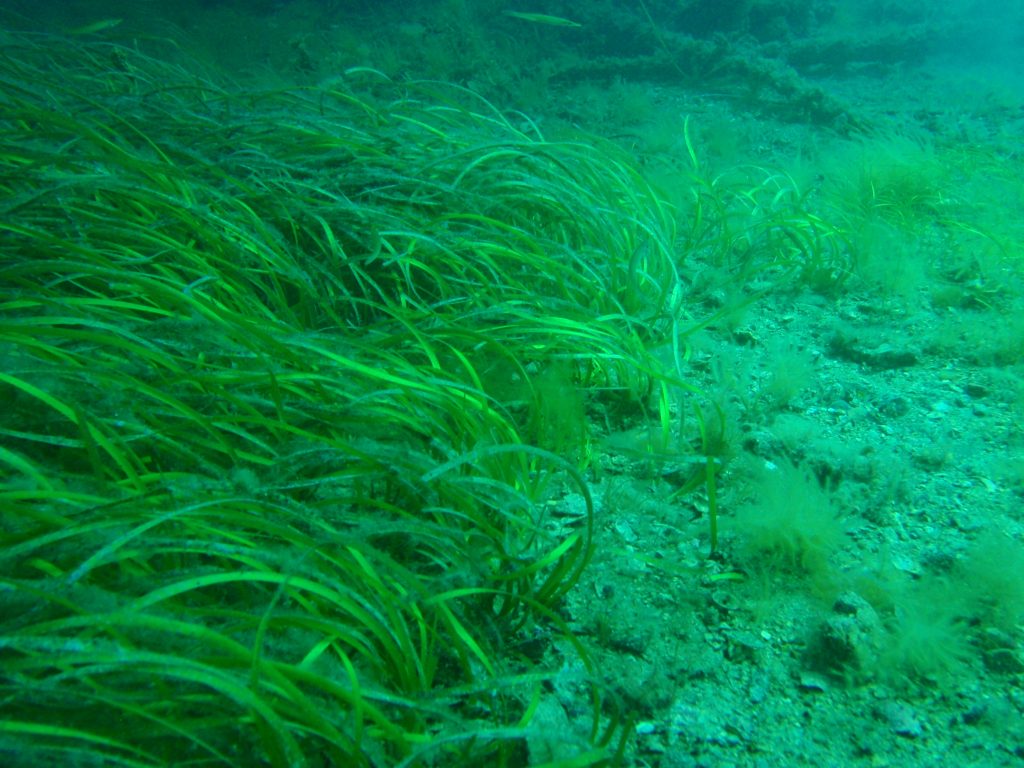“… sets in motion a chain reaction that massively increases the fish population.”
“Fish absorb huge quantities of CO2… meaning the increase in their numbers would benefit the climate in a similar way to forests.”
.
We have a very valuable marine resource in Lyme Bay:
… providing carbon capture and essential habitats.
Seagrass in Lyme Bay – Vision Group for Sidmouth
This plant provides all sorts of ‘ecosystem services’:
Seagrass as ecosystem service: naturally removing plastics – Vision Group for Sidmouth
Meanwhile, down the coast, England’s largest seagrass planting programme has been taking place in the UK’s first National Marine Park:
“Providing homes for juvenile fish and protected creatures, stabilising the seabed, cleaning the surrounding seawater and capturing and storing significant amounts of carbon.”
Seagrass in Plymouth Sound – Vision Group for Sidmouth
It appears that there are indeed several ‘ecosystems services’ which seagrass can provide, as Tom Bawden writes in the i paper. Here’s the first part of a long interview:
Climate change: Former chief scientist Sir David King says restoring fish to the seas could help solve crisis

The UK could increase the number of fish in its waters 10 times over within just 15 years by adding seaweed and desert sand to the ocean, according to one of the world’s leading climate change experts. Boosting seafood stocks in this way would provide a crucial climate-friendly alternative to meat and other protein production at the same time as sucking vast quantities of planet-warming carbon dioxide out of the atmosphere through the oceans, he said. Fish absorb huge quantities of CO2 and excrete much of it in droppings that fall to the sea floor, meaning the increase in their numbers would benefit the climate in a similar way to forests.
“I would like to see whether we can restore the ocean fish and mammal population to something like it was 300 or 400 years ago. I do think that’s doable – and it would be a major new provider of protein for the world,” Professor Sir David King told i. Sir David was the UK government’s chief scientific adviser from 2000-2007 and government and later was Britain’s Special Representative for Climate Change from 2013-2017.
It has already been scientifically demonstrated that planting seaweed and seagrass – and sprinkling iron on the surface of the ocean, possibly in the form of desert sand or volcanic dust – sets in motion a chain reaction that massively increases the fish population, he said. The iron acts as a fertiliser for seaweed such as giant kelp “which is the fastest growing green plant in the world by a factor of 30 or 40”, he added. That stimulates the production of animal plankton – “the starting foodstuff for fish larvae.
“The average female fish lays about 100,000 eggs in a year, which means that the oceans are replete with fish eggs and when they hatch as larvae they die because there’s usually no food stock for them,” Sir David said. “But by creating vast green areas, of maybe 50,000 square kilometres, with a very high density of plankton, they will live. So within three months you’ve got many billions of fish in a small area.”
Sir David said he was well aware that his hopes were not shared by everyone, and cautioned that they might come to nothing. “This is intervening in natural processes and is actually quite controversial. Many ecologists are saying, ‘You’ve just got to be so damn careful when you intervene in the ocean biomass system.’ We’re still in a state of ignorance,” he conceded. One fear is that algal blooms can suck much-needed oxygen out of the water – while there are also concerns about unforeseen and unintended consequences.
To that end, Sir David and the Centre for Climate Repair he set up at Cambridge University is leading a worldwide four-year trial of the main fish-boosting techniques, starting next year. This will look to provide further evidence that fish stocks can be significantly increased. But more importantly, it aims to understand whether the process may cause harm – and if there are remedies. The trial will bring together institutions from across the world, including Southampton and Portsmouth universities in the UK.
With a little more here:
The Complicated Role of Iron in Ocean Health and Climate Change | Science | Smithsonian Magazine
Q&A: How Desert Dust Storms Supply Vital Nutrients to the Oceans | Inter Press Service
How Growing Sea Plants Can Help Slow Ocean Acidification – Yale E360